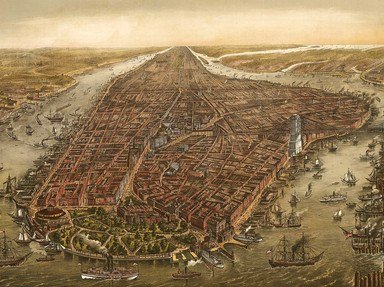Quiz Answer Key and Fun Facts
1. Fort Clinton, Castle Clinton, Castle Garden, Battery Park. This site served as a fort, an opera house, a beer garden, an aquarium and a public park. What was its purpose between 1855 and 1892?
2. The main branch of the New York Public Library on 5th Avenue opened in 1911. Another great municipal structure was demolished to make way for the library. What was it?
3. Fifth Avenue and 34th Street. First came the William Waldorf Astor mansion, then came the original Waldorf-Astoria Hotel. What's there now?
4. In 1963, the magnificent beaux-arts Pennsylvania Station (1911) was demolished, though a station still exists underground. What replaced the building?
5. In 1896, Columbia University began moving uptown to Morningside Heights. What New York landmark now occupies the site of the former Columbia campus in midtown Manhattan?
6. Flushing Meadows Park in Queens hosted the New York World's Fairs of 1939-40 and 1964-65. Only one building from the 1939-40 Fair is still standing in its original location. What is it?
7. The Winter Garden Theater on Broadway was remodeled in 1911 - and a good thing, too! What was the building's original purpose?
8. On the grounds of Columbia University Medical Center in Washington Heights, there's a bronze plaque shaped like home plate, marking the site of old Hilltop Park. Which NYC baseball team built the Park?
9. Octagon Tower has stood on Roosevelt Island in the East River since the 1830s. It's now the lobby of a modern apartment complex. What was its original purpose?
10. Historic Trinity Church stands at the intersection of Broadway and Wall Street in downtown Manhattan. It's the third church building on this site. What happened to the original structure, built in 1698?
11. In 1823, a classical building was erected on Wall Street for the New York branch of the Bank of the United States. It was demolished in the early 20th century - almost. The facade was saved and re-erected further uptown. Where?
12. Canal Street in lower Manhattan follows the route of ... an old canal. What was the long-gone canal's purpose?
13. The Statue of Liberty was dedicated in 1886, but the island on which it stands was given to the federal government in 1800 for another purpose. What was it?
14. Federal Hall National Memorial stands on Wall Street, not far from the New York Stock Exchange. The existing structure dates from 1842. What was the first public building to occupy this historic site?
15. Times Square, "Crossroads of the World" - since 1904, at least. What was it called before the New York Times arrived?
Source: Author
ignotus999
This quiz was reviewed by FunTrivia editor
bloomsby before going online.
Any errors found in FunTrivia content are routinely corrected through our feedback system.

